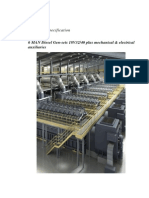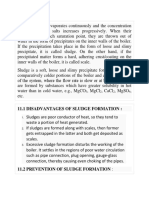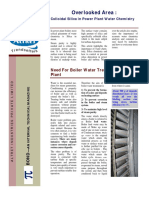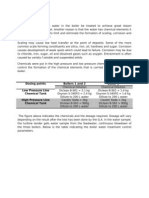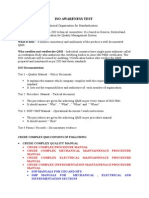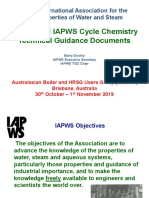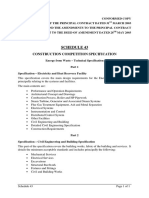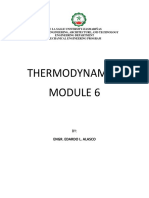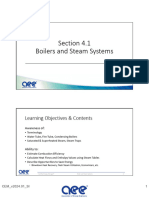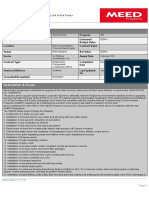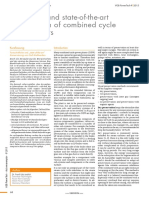Boiler Water Treatment Fundamentals
Boiler Water Treatment Fundamentals
Uploaded by
sauravsinhaaCopyright:
Available Formats
Boiler Water Treatment Fundamentals
Boiler Water Treatment Fundamentals
Uploaded by
sauravsinhaaOriginal Description:
Original Title
Copyright
Available Formats
Share this document
Did you find this document useful?
Is this content inappropriate?
Copyright:
Available Formats
Boiler Water Treatment Fundamentals
Boiler Water Treatment Fundamentals
Uploaded by
sauravsinhaaCopyright:
Available Formats
Co-ordinated Phosphate treatment program and its control towards boiler water chemistry Need for Phosphate treatment
- Deposition control
Deposition is a major problem in the operation of stream generating equipment. Deposition is accumulation of material on boiler surfaces that can cause overheating as well as circulating restrictions. Both conditions frequently result in unscheduled outages. Many solids, soluble in boiler feedwater, precipitate in boiler water. This happens for one or both of two reasons. Change in water chemistry when going from feedwater to boiler water conditions, and retrograde solubility characteristics of some salts. Calcium, Magnesium, iron, copper, aluminum, silica and to a lesser e tent silt and oil are common contaminants in boiler feed water that can form deposits. ! act combinations in which they e ist are different from boiler to boiler and even location to location. The precipitation is however, usually somewhat selective for any given boiler water chemistry. "n one boiler, #cale may form as calcium silicate, in another as sodium iron silicate. #alts are not totally insoluble in boiler water, But the lose solubility as solution temperature increases, often precipitate directly on tube surfaces. There are two basic methods of applying internal boiler water treatment for the control of deposition. Chelent$dispersant and %hosphate$dispersant .&ne is a solubilising program and other is a precipitation program. Calcium sulfate scaling was major recogni'ed problem in internal treatment of boiler water. #odium carbonate was the std precipitating agent used in internal treatment in past. Calcium carbonate is less soluble than calcium sulfate and the objective was to precipitate calcium as calcium carbonate rather than as calcium sulfate. (a)C&* + Ca#&, ------. CaC&* + (a)#&,/ B0T at high Temp1 (a)C&* +2)& -. C&) + )(a&2 The driving force for the reaction is maintenance of the high concentration of carbonate ion in the boiler water. 3s boiler pressure increases slowly around )44 psi 56*.7 8g$cm) g9, it becomes very difficult to maintain the high concentration of carbonate ion in the boiler water due to the decomposition of carbonate ion at higher boiler water temperature. #odium carbonate decomposes in the boiler forming sodium hydro ide and carbon dio ide. The C&) leaves the boiler with the steam increasing the corrosivity of steam condensate. Phosphate Control. %hosphate ion does not decompose as does carbonate ion at higher boiler water temperatures. This obvious advantage favors phosphate over carbonate, together with the fact that calcium phosphate is more insoluble than calcium carbonate. Calcium phosphate is virtually insoluble in boiler water. Maintaining even small levels of phosphate will ensure the precipitation of calcium phosphate in mid-stream away from heating surfaces. The introduction of phosphate treatment eliminated calcium carbonate scale. :hen calcium phosphate is formed in boiler water of sufficient al8alinity 5p2 66.4 to 6).49, a particle of relatively non-adherent surface charge is produced. This is not to say that over a period of time deposit accumulations do not develop, they do, but they can be reasonably well controlled with blowdown. The introduction of phosphate-based boiler-water al8alinity control brought a major improvement to the development of programs with p2 control based upon free (a&2. The application of phosphate either by itself, or in conjunction with caustic soda, could provide the elevated p2 necessary to minimi'e the corrosion of carbon steel. 3t the same time, the phosphate also provided sufficient chemical buffering capacity to cope with small system upsets, e.g., a small condenser lea8. %hosphate was also economical and easy to use. :hile phosphate had the ability to significantly curtail incidents of caustic embrittlement and caustic gouging damage, it could not totally remove the fear of having free hydro ide in e cess of that associated with Tri sodium phosphate. There was a need to get tighter control. Coordinated Phosphate Treatment #team generating unit, supplied with deminerlised or evaporated ma8es up water, or pure condensate may be protected from caustic centered damage by using general term Coordinated
pH/Phosphate control. %hosphate is a buffer in this program and limits the locali'ed concentration of caustic. ! cess caustic combines with disodium phosphate and forms Trisodium phosphate. ;or the program to wor8, "t is esstional to have sufficient disodium phosphate available to combine with free caustic to form tri sodium phosphate. The hydrolysis of T#% is often used to e plain the mechanism of a coordinated p2$phosphate program. :hen T#% is dissolved in water, it dissociates, forming sodium hydro ide and disodium phosphate1 (a*%&, + 2)& Trisodium water %hosphate (a&2 + (a)2%&, sodium Di sodium hydro ide phosphate
Consequently, when an equal molar mi ture of caustic soda and disodium phosphate is evaporated to dryness, only Trisodium phosphate remains - not sodium hydro ide and disodium phosphate. Trisodium phosphate is the least soluble of this trio and precipitates first. The restriction imposed is that the sodium hydro ide molar ratio must be equal to less than the disodium phosphate molar ratio. "n boiler water having a high concentration of bicarbonate al8alinity 5(a2C&*9 in the feed water, it may be necessary to control a coordinated p2$phosphate program on a sodium to phosphate molar ratio. "n this case, the sodium concentration is measured and controlled equal to or less than three times the phosphate molar concentration. The sodium carbonate concentration is important because beneath the iron o ide deposit build up, of any area of over-concentration, further decomposition of carbonate can occur than occurs in a bul8 boiler water. This will cause the formation of additional sodium hydro ide and carbon dio ide will pass out of the concentrated site with the steam. Coordinated p2$phosphate programs are normally set up to ta8e this into account, and are maintained between ).< to ).= molar ratio of sodium to phosphate.
For HP boilers,all the points should be within the Red color boundary limits. For MP boilers,all the points should be within the Blue color boundary limits. For LP boilers,all the points should be within the Green color boundary limits.
NaOH TSP D#%
*molar ratio line
Phosphate & pH limits for Process Boilers (Coordinated Phosphate/pH Chart) 10.8 10.7 10.# 10." 10.! 10. 10.2 10.1 10.0 9.9 9.8 9.7 2" 0
Blowdown
pH of B%
2%
M%
>%
"
!0
!" P$! conc in B%
"0
""
#0
#"
Action of TSP towards Boiler water. Boiler feed water systems using D.M ma8eup or pure condensate may be protected from (a&2 attac8 throu? C%T %&, buffers the boiler water reducing the chance of large p2 changes due ti development of high caustic concentrations.! cess caustic combines with D#% and Trisoduim phosphate sufficient D#% must be available to combine with all free caustic in order to form T#%. Moreover the action of T#% in the process boilers is given by following reactions. (a*%&, 5T#%9 + 2)& 5water9 (a)%&, 5D#%9 + (a&2 5caustic9
The added Ma treat-*))* # first reacts with the boiler water forms Di sodium phosphate and sodium hydro ide .The D#% formed with be ta8ing care of the %hosphate content in the boiler water where as the (a&2 formed will care of p2 of the boiler water.
Phosphate hide-out
@%hosphate hideout@ and @chemical hideout@ are terms used to describe the loss of boiler water phosphate residual that accompanies this solid phase formation problem. Typically, phosphate tends to @disappear@ as load 5steaming rate load9 is increased towards ma imum. The p2 will also vary, usually in an upward direction, although one would e pect that the change in p2 would be consistent with the change in (a1%&, ratio of the solution. The upward trend in p2 may be e plained by an interaction between phosphate and magnetite that is also 8nown to e ist. Aust as phosphate disappears with increasing load, so does it reappear with decreasing load, with concurrent impact on the system p2. Dissolution of the solid phase occurs as load is reduced. The phosphate hideout phenomenon can pose a significant chemistry control problem in high pressure boilers that e perience load variations. !ssentially all reported cases of boiler tubes e periencing phosphate-induced corrosion have been associated with phosphate hideout. "n spite of hideout being a locali'ed phenomenon, it may become visible in the bul8 sample when the boiler changes load. 3s the boiler pressure is brought up to full load, hide-out will appear as a loss of phosphate from solution accompanied by an increase in p2 and al8alinity. Typically, the phosphate concentration may drop below the levels specified for coordinated or congruent treatments while the p2 goes above B.7. ;ollowing a load reduction or shutdown, the phosphate may start to reappear with the p2 dropping, possibly below B.4.
ffect of low pH and hi!h pH "al#es in the boiler$ Maintenance p2 proper p2 throughout the boiler feedwater, boiler and condensate systems is esstional for corrosion control. Most of the low %r boiler systems operators monitor boiler water al8alinity because it correlates very closely with p2, while most of the feed water. Condensate and high pr boiler requires direct monitoring of p2. Control of p2 is important for the following reasons. Corrosion rates of metals used in boilers systems are sensitive to variation to p2. >ow p2 or insufficient al8alinity can result in corrosive acidic attac8 2igh p2 or e cess al8alinity can result in caustic gouging$crac8ing and foaming, with resultant carryover. #peed of the o ygen scavenging reactions is highly dependent on p2 levels. The distribution ratio of silica between steam and boiler water depends upon two major factors. &ne of major factor is p2 of the boiler water. 2igher p2 of the boiler water decreases the silica carryover. The effect of boiler water p2 on silica ratio becomes greater at higher p2 values where an increase of p2 from 66.*-6).6 reduces the silica ratio by C4D,while an increase of p2 from 7.<-B.4 shows no measurable effect .
p2 and al8alinity level maintained in a boiler system depends on many factors, such as systems pressure, system metals, feed water quality, and type of chemical treatment applied. The corrosion rate of carbon steel at feed water temp 3pproaches a min. value in p2 range of B.)-B.=."t is important to monitor the feed water system for corrosion by means of iron and copper testing. ffect of hi!h PO% and &ow PO% content in the boiler The mechanism for the reaction of phosphate with metal o ides has been found that the reaction of phosphate with magnetite results in the formation of two products. &ne has the composition (a,;e&25%&,9)E6$*(a&2. "f the Na/PO% ratio was less than '.( 5as can be e pected from trying to 8eep within the bounds of C%T by blending in disodium or monosodium salts9 and the temperat#re was in the )'*-)+*,C re!ion, the other product was (a;e%&, or maricite, formed as a result of these acidic phosphate salts attac8ing both the magnetite and the base metal..
2Na2HPO4 + Fe3O4 NaFePO4 + Na3PO4 + Fe2O3 + H2O 2Na2HPO4 + Fe + !O2 NaFePO4 + Na3PO4 +H2O 3NaH2PO4 + Fe3O4 3NaFePO4 + !O2 + 3H2O
-hen the Na/PO% ratio was abo"e '.( and the temperat#re )'*,C, the other product was (a).=;e4.)%&, rather than maricite. "f the Na/PO% ratio went abo"e '.. and the temperat#re was raised to )+*,C, 2) was formed as a result of a high local concentration of (a&2 first dissolving the magnetite and then base metal. The presence of the hydrogen gas can be an indication that caustic gouging is occurring.
4NaOH + Fe3O4 2NaFeO2 + Na2FeO2 + 2H2O 2NaOH + Fe Na2FeO2 + H2
"f the concentration of phosphate is in equilibrium with the system, then the phosphate should remain in solution with blowdown as the only mechanism by which it will be changed. "f the phosphate addition is continuous, the bul8 sample, will then represent the steady-state average from balancing what is fed into
the boiler with what is being removed by blowdown. "f the addition pump can be isolated and no more phosphate added, the phosphate concentration should fall at a rate dependent upon the blowdown flow. "f there is no blowdown, then the phosphate concentration should remain constant. The %&,, p2 and (a$%&, ratio should also remain fairly constant in spite of load changes. "f phosphate is present at a concentration in e cess of the equilibrium value, the e cess will deposit within the system. This deposition process provides a second removal mechanism in addition to blowdown. The phosphate concentration within the bul8 fluid will drop at a rate dependent upon the sum of the rates of blowdown and deposition until such time as the equilibrium concentration is reached. 3t that point, the deposition will cease and the concentration will fall only in proportion to the blowdown rate. :hile the %& , is above the equilibrium value, the %&,, p2 and (a$%&, ratio are li8ely to show movement in response to load changes. "f the phosphate is present at a concentration below the equilibrium value, deposits from tube surfaces within the system will redissolve. The redissolution would be seen as a sudden increase in phosphate when a unit trips. "t may also, if given enough time, provide a mechanism to at least partially remove old deposits. "t also provides the necessary al8alinity to maintain the system during a shutdown state. Based on "ector control dia!ram followin! actions to be ta/en when specified #pset occ#rs$ "n boiler water when p2 values are low and %&, values are maintaining, then add caustic lye to dosing tan8 to increase the molar ratio of the solution. This is shown by green color arrow in the vectors. "f %&, content is low, but p2 values are maintaining then add D#% to the dosing tan8 solution to maintain the higher %&, content in the Boiler water. :hich is indicated by blue color. "f both p2 and %&, content are low, then add T#% solution to boiler water to increase the same. "f both p2 and %&, values were high then give blowdown to the system to reduce the same. "ndicated by red color. Trouble shooting1 -
%roblems type13cute problems 6.#udden p2 and %&, soot-up ).Feduction in p2 and %&, values. *.>ow %&, problems.
%ossible reasons 6.More %&, dosing. ).#udden reduction in loads. 6.! tra unwanted Blowdown ).#udden increase in load. Dosing pump Mal-functioning. ! cess blowdown.
3ction to be ta8en Feduce the %ump dosing. Calculated amount of Blowdown. "ncrease the dosing rate. Controlling Blowdown. %roper operation of pump &ptimi'ation of Blowdown flowrate
#ome of the perennial problems are due Mal-functioning of dosing pump, low$high molar-ratio and concentration of the dosing solution.
Calc#lation1 3mount of dosing solution to be dosed to attain required amount of %&, content in boiler water, at absence of blowdown. Consider1 Capacity of pump is Golume of water present in the steam drum including the circulating water "nitial %&, content of the boiler water is Fequired %&, content is %&, concentration of dosing tan8 solution Then, 3mount of dosing solution to be dosed H Gol. water I 5required %&, content - 3vailable %&, content9 Concentration of dosing tan8 solution. H H C444I5C4-)C9$C444 )C liters C lit$min C tons )C ppm C4 ppm C444 ppm as %&,
As per the p#mp capacit0 we ha"e dose at 1**2 sto/e for (hrs O3 at (*2 sto/e for 1*hrs. Blow down Calc#lation$ Consider the boiler water present %&, content as Fequired amount of Boiler water %&, content is Golume of water present in the boiler drum Then, Gol. &f water to be drained H Gol. of water present in the steam drum I required %&, concentration %resent %&, concentration of the boiler water. H H Then4 '(** &iters of water to be drained to maintain the PO% content as %*ppm. C444I,4$<4 )C44 liters. <4ppm ,4ppm CTons.
5olar ratio of the dosin! sol#tion$ Trisodium %hosphate 5(a* %&,91 Consists of * moles of #odium and one mole of %hosphate. %ure T#% 3lways has *16 (a to %&, ratio. "n manuf. &f T#% the purity is always based on the %&, concentration in the material. (ormally 644D pure T#% consists of CCD of %&, content. The sodium concentration is not considered in terms of purity of the T#%. The molar ratio of the solution can be calculated by Concentration of sodium$moli.wt of sodium Molar ratio H Concentration of %hosphate$moli.wt of %hosphate Molecular weight of #odium Molecular weight of %hosphate H H )* B7
&n application, The equation becomes as 5Conc. of sodium $ Conc. of %hosphate9 I ,.) H molar ratio of %hosphate solution.
#ignificance of molar ratio1 >ow molar ratio of the dosing solution causes low p2 and high %&, problem. Because amount of sodium dosing is less compared to amount of %hosphate dosed in the system. "f it is found molar ratio of the solution is low and Caustic lye can be added to increase the sodium content of the solution as well as molar ratio of the solution. 2igh molar ratio of the dosing solution causes high p2 and low phosphate problems in boiler water. 3llows free caustic to e ist in boiler water and causes caustic embrittlement. #ignificance of %J M al8alinity1 %henolphthalein - al8alinity Methyl - al8alinity 6n boiler water4 6f we obser"e 'P-5 is less then or e7#al to 8ero then we can ens#re that that no free Ca#stic is present in the boiler water. Hence chances of Ca#stic embrittlement is ne!li!ible.
You might also like
- Boiler Water TreatmentDocument7 pagesBoiler Water TreatmentJAY PARIKH100% (2)
- ASME Boiler Feed WaterDocument30 pagesASME Boiler Feed WaterHendri KurniawanNo ratings yet
- Boiler-Water Treatment-Why, What and HowDocument7 pagesBoiler-Water Treatment-Why, What and How陳0鴻100% (1)
- Boiler Water TreatmentDocument37 pagesBoiler Water Treatmentrajendick61% (18)
- Technical Diary ThermalDocument121 pagesTechnical Diary ThermalKush SharmaNo ratings yet
- 50-MW 18V-32-40 HFO 50-HZ 6-Units Technical ProposalDocument73 pages50-MW 18V-32-40 HFO 50-HZ 6-Units Technical ProposalRamesh Chandra Gupta86% (7)
- Panduan KKS SiemensDocument54 pagesPanduan KKS SiemensAnonymous GVfWfdNo ratings yet
- Boiler Phosphate TreatmentDocument4 pagesBoiler Phosphate TreatmentSilvina C. Gómez Correa0% (1)
- Why Is TSPDocument4 pagesWhy Is TSPAbhi SharmaNo ratings yet
- Water Chemistry PDFDocument8 pagesWater Chemistry PDFalam100% (1)
- Boiler Water Chemistry Analysis PB QBook PDFDocument8 pagesBoiler Water Chemistry Analysis PB QBook PDFelgawadhaNo ratings yet
- 0372 0375 Vol A1 t02 Water ChemistryDocument71 pages0372 0375 Vol A1 t02 Water ChemistrySandeep MishraNo ratings yet
- Power Plant ChemistryDocument136 pagesPower Plant ChemistryGajender Singh Rajput100% (1)
- Boiler Water BBGS PDFDocument32 pagesBoiler Water BBGS PDFproloy12No ratings yet
- Boiler Water TreatmentDocument30 pagesBoiler Water TreatmentDeo Anugrah Utomo100% (6)
- Wet Lay Up in BoilerDocument5 pagesWet Lay Up in Boilersprotkar100% (1)
- Boiler Feed Water TreatmentDocument18 pagesBoiler Feed Water TreatmentBIDYUT CHAKRABORTYNo ratings yet
- 7 Steps To Boiler Chemical Cleaning and Treatment Selection in Thermal Power PlantDocument9 pages7 Steps To Boiler Chemical Cleaning and Treatment Selection in Thermal Power PlantMohamed Tally100% (1)
- 7.0 Chemical Treatment: Association of Water Technologies - Technical ManualDocument38 pages7.0 Chemical Treatment: Association of Water Technologies - Technical ManualWaleed Emara100% (1)
- Calcium Phosphate Scale Formation From Simulated Milk Ultrafiltrate SolutionsDocument8 pagesCalcium Phosphate Scale Formation From Simulated Milk Ultrafiltrate SolutionssegundosoporteNo ratings yet
- Rangkuman AVTDocument3 pagesRangkuman AVTM.Muhardi NurNo ratings yet
- Chlorination of Cooling Water Systems PDFDocument4 pagesChlorination of Cooling Water Systems PDFhappale2002No ratings yet
- Phosphate HideoutDocument3 pagesPhosphate HideoutGreater Potential Tutoring100% (1)
- Chapter 11 - Preboiler and Boiler CorrosionDocument19 pagesChapter 11 - Preboiler and Boiler CorrosionEngr Irfan Akhtar100% (1)
- KURITA - Boiler Preservation Methods (Part1) PDFDocument7 pagesKURITA - Boiler Preservation Methods (Part1) PDFIyan Mulyana100% (1)
- Co-Ordinated and Congruent Phosphate Treatment of Boiler WaterDocument3 pagesCo-Ordinated and Congruent Phosphate Treatment of Boiler WaterRavi Shankar50% (2)
- Boiler Water Chemistry: Korba Simulator 339Document12 pagesBoiler Water Chemistry: Korba Simulator 339Rakesh Kiran100% (2)
- Boiler Water TreatmentDocument13 pagesBoiler Water Treatmentgagan singh100% (1)
- Boiler Water ConditioningDocument3 pagesBoiler Water ConditioningShahin AfrozNo ratings yet
- Silica Carryover in BoilerDocument3 pagesSilica Carryover in BoilermnasiroleslamiNo ratings yet
- Steam PurityDocument2 pagesSteam PurityMunawar Hussain100% (1)
- Boiler Water AnalysisDocument44 pagesBoiler Water AnalysisDileep MishraNo ratings yet
- Boilers Water TreatmentDocument94 pagesBoilers Water TreatmentalvarompsardinhaNo ratings yet
- Pi Bond Collodial Silica in Power Plant Water ChemistryDocument4 pagesPi Bond Collodial Silica in Power Plant Water Chemistryak_thimiriNo ratings yet
- ? - Oxygen ScavengersDocument4 pages? - Oxygen ScavengersJim FrenkenNo ratings yet
- Boiler Water TreatmentDocument22 pagesBoiler Water TreatmentTarun Patel50% (2)
- Boiler Water Quality RecommendationsDocument7 pagesBoiler Water Quality Recommendationsnishanth930No ratings yet
- Cathotic ProtectionDocument5 pagesCathotic Protectionkrishna_swaroop99100% (1)
- Boiler Cycle Control: Questions and AnswersDocument6 pagesBoiler Cycle Control: Questions and AnswersChanBoonChew100% (1)
- Best Practice in Boiler Water Treatment Part 2Document6 pagesBest Practice in Boiler Water Treatment Part 2Adrian MicuNo ratings yet
- Cooling Water - PackariousDocument57 pagesCooling Water - PackariousBrett RagonNo ratings yet
- Preservation of Boiler 1Document21 pagesPreservation of Boiler 1Dangol100% (1)
- 6 - Presentation - Boiler Water ChemistryDocument100 pages6 - Presentation - Boiler Water Chemistrymuks1308100% (1)
- Silica Selective TF-5Document3 pagesSilica Selective TF-5mnasiroleslamiNo ratings yet
- High Pressure Boiler ChemistryDocument67 pagesHigh Pressure Boiler ChemistryJayanath Nuwan Sameera100% (2)
- Boiler WaterDocument70 pagesBoiler WaterDarius Dsouza100% (1)
- Trouble Shooting Water Carry Over in BoilersDocument6 pagesTrouble Shooting Water Carry Over in BoilersAnonymous OkaG2V100% (2)
- Water Treatment For BoilersDocument48 pagesWater Treatment For BoilerssamettekNo ratings yet
- 216Document16 pages216Mehdi NasiroleslamiNo ratings yet
- All You Need To Know About Boiler Feed Water Treatment E-Book-1 PDFDocument37 pagesAll You Need To Know About Boiler Feed Water Treatment E-Book-1 PDFHazem Alsharif100% (2)
- Feed Water ManagementDocument31 pagesFeed Water ManagementAnmol AgarwalNo ratings yet
- Coal Additive PresentationDocument15 pagesCoal Additive PresentationNileshNo ratings yet
- Boiler-Water ChemistryDocument94 pagesBoiler-Water ChemistryPRAG100% (4)
- Boiler Water Chemistry: 1. Formation of Scales & Deposits On The Boiler TubesDocument4 pagesBoiler Water Chemistry: 1. Formation of Scales & Deposits On The Boiler TubesKumaraswamy100% (3)
- Carryover in BoilerDocument2 pagesCarryover in Boilershan877100% (1)
- Boilers Water Treatment: Chemist / Mustafa Ateia MustafaDocument38 pagesBoilers Water Treatment: Chemist / Mustafa Ateia MustafaMakhdoom Ibad HashmiNo ratings yet
- Water Treatment Plant Working PrincipleDocument2 pagesWater Treatment Plant Working PrincipleTosin Opawole100% (1)
- Causes of CarryoverDocument3 pagesCauses of CarryoverRajesh SarkarNo ratings yet
- Boiler Water TreatmentDocument1 pageBoiler Water TreatmentRommel Cena Nepalar100% (1)
- Boiler Waterside DepositionDocument6 pagesBoiler Waterside DepositionMohamad EshraNo ratings yet
- Boiler Water Treatment - WhyDocument53 pagesBoiler Water Treatment - Whymechetron100% (8)
- Real Time Boiler TreatmentDocument4 pagesReal Time Boiler TreatmentJustin GentryNo ratings yet
- Boiler Feed Water and Its Treatments 1Document27 pagesBoiler Feed Water and Its Treatments 1Rahul AhujaNo ratings yet
- Boiler Feed Water Specifications - Specifications of Boiler WaterDocument9 pagesBoiler Feed Water Specifications - Specifications of Boiler WaterJean Yure100% (1)
- Fire Quiz QuestionsDocument22 pagesFire Quiz Questionssauravsinhaa50% (2)
- GATE 2012 Solved PaperDocument20 pagesGATE 2012 Solved PapersauravsinhaaNo ratings yet
- Dream Endowment Plan BrochureDocument10 pagesDream Endowment Plan BrochuresauravsinhaaNo ratings yet
- Iso Awareness TestDocument3 pagesIso Awareness TestsauravsinhaaNo ratings yet
- Earth Cutting and Filling Estimation CalcDocument2 pagesEarth Cutting and Filling Estimation CalcsauravsinhaaNo ratings yet
- Mutual Fund Advisory Services: Returns CalculatorDocument4 pagesMutual Fund Advisory Services: Returns CalculatorsauravsinhaaNo ratings yet
- Jamnagar City DetailsDocument189 pagesJamnagar City DetailssauravsinhaaNo ratings yet
- Gas Turbine CyclesDocument2 pagesGas Turbine CyclessauravsinhaaNo ratings yet
- MS Excel HelpDocument3 pagesMS Excel HelpsauravsinhaaNo ratings yet
- Control Valve Sizing, Liquid FlowDocument2 pagesControl Valve Sizing, Liquid FlowsauravsinhaaNo ratings yet
- IAPWS and IAPWS Cycle Chemistry Technical Guidance DocumentsDocument40 pagesIAPWS and IAPWS Cycle Chemistry Technical Guidance DocumentsOsu AmpawanonNo ratings yet
- Chemical Boiling Out Procedure Boiler BDFB 350-1004. Rev.00Document7 pagesChemical Boiling Out Procedure Boiler BDFB 350-1004. Rev.00Ari Puji Hidayatullah0% (1)
- Construction Competition SpecificationDocument625 pagesConstruction Competition Specificationsammar_10No ratings yet
- MEET 223 Module 6Document22 pagesMEET 223 Module 6Kurt PalacioNo ratings yet
- 04.1 - Boilers and Steam Systems - v2024.01 - CEM - SIDocument36 pages04.1 - Boilers and Steam Systems - v2024.01 - CEM - SIanoopenovaNo ratings yet
- Lecture 9 Erosion-CorrosionDocument27 pagesLecture 9 Erosion-Corrosionprakush01975225403No ratings yet
- Engineering-Chemistry - 3 SEM 1 - U2Document30 pagesEngineering-Chemistry - 3 SEM 1 - U2Alice LewisNo ratings yet
- Byco Internship ReportDocument38 pagesByco Internship ReportKhaqan Majeed100% (2)
- MH BOE 2014 Paper 1 SolutionDocument15 pagesMH BOE 2014 Paper 1 SolutionPratima MondalNo ratings yet
- Boiler Tuning BasicsDocument18 pagesBoiler Tuning BasicsLester Pino100% (1)
- Steam Boilers, Engines, Nozzles and Turbines - Mechanical Engineering Multiple Choice Questions and Answers Mechanical Engineering Multiple Choice Questions - pdf-1Document33 pagesSteam Boilers, Engines, Nozzles and Turbines - Mechanical Engineering Multiple Choice Questions and Answers Mechanical Engineering Multiple Choice Questions - pdf-1PARESH JASANI100% (1)
- EATCO - Suez Petrochemicals Complex - Gas To Polyolefins IIDocument180 pagesEATCO - Suez Petrochemicals Complex - Gas To Polyolefins IIAndrzej SzymańskiNo ratings yet
- Upgrade of Sulfur Recovery Unit at Ras TanuraDocument8 pagesUpgrade of Sulfur Recovery Unit at Ras Tanurasalman KhanNo ratings yet
- FINEAMIN BrochureDocument6 pagesFINEAMIN Brochuremuh4iminNo ratings yet
- Construction, Installation, Inspection & Maintenance of High Pressure Boilers PDFDocument66 pagesConstruction, Installation, Inspection & Maintenance of High Pressure Boilers PDFObe MendozaNo ratings yet
- VGB PowerTech Magazine Article PDFDocument7 pagesVGB PowerTech Magazine Article PDFWaleed EmaraNo ratings yet
- SDS SUNOX 335 - MergedDocument7 pagesSDS SUNOX 335 - MergedPT. CITA RASA PALEMBANGNo ratings yet
- Power Systems - I Question BankDocument78 pagesPower Systems - I Question BankSuparna DebNo ratings yet
- HRSG ArticleDocument26 pagesHRSG Articlehafizi07No ratings yet
- Report Mill and Boiler FinalDocument35 pagesReport Mill and Boiler FinalMuhammad Nur ShidiqNo ratings yet
- Guidance of Piping DesignDocument121 pagesGuidance of Piping DesignTapas PalitNo ratings yet
- Severe Service Valve SolutionDocument20 pagesSevere Service Valve SolutionGabrieldiazNo ratings yet
- CFB Boiler Babcock Br-1629Document9 pagesCFB Boiler Babcock Br-1629Diệp ThắngNo ratings yet
- Pharmaceutical Steam Generators and Water Distillation SystemsDocument12 pagesPharmaceutical Steam Generators and Water Distillation Systemssoajanii100% (2)
- That HousesDocument9 pagesThat HousesAri BinukoNo ratings yet
- Whrs ManualDocument41 pagesWhrs ManualAKHLESH JHALLARENo ratings yet





